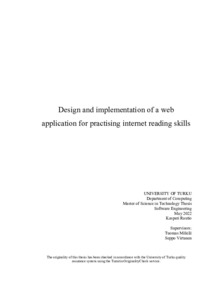Design and implementation of a web application for practising internet reading skills
Rautio, Kasperi (2022-05-25)
Design and implementation of a web application for practising internet reading skills
Rautio, Kasperi
(25.05.2022)
Julkaisu on tekijänoikeussäännösten alainen. Teosta voi lukea ja tulostaa henkilökohtaista käyttöä varten. Käyttö kaupallisiin tarkoituksiin on kielletty.
avoin
Julkaisun pysyvä osoite on:
https://urn.fi/URN:NBN:fi-fe2022060141808
https://urn.fi/URN:NBN:fi-fe2022060141808
Tiivistelmä
Being able to critically evaluate the reliability of sources is an important skill, and a part of digital literacy competences and internet reading. Conducting research on the matter and teaching the skills related to internet reading in a digital environment require discrete software that is designed for said purposes. This thesis is associated with a project where one of the objectives is to design and implement a new web application, StudentNet, where pupils can practise and improve their skills in internet reading by completing assignments. Internet reading is goal-directed activity where the reader a) searches for information to set questions from the Internet, b) evaluates the reliability of the found information, and c) composes a synthesis based on several online sources.
The basis of StudentNet is a web application called Neurone, which main purpose is research and measurement instead of education, and it provides a linear user flow. In contrast, StudentNet should provide a nonlinear model regarding the application’s user flow. In this thesis it is studied how this nonlinear model works in practice especially when the users are children, and what specific things should be considered when developing software for educational purposes.
Several practical experiments were organised during the project. In these experiments, each participant completed an assignment in StudentNet and answered a set of statements in an end questionnaire. In addition, log data of users’ interactions in the application was recorded. The data collected from the questionnaire was analysed and utilised to get some information on what could be improved, and ideas for the development of new features as well as improving existing ones. In addition, the gathered feedback was used to answer the research question considering the application’s nonlinear model. It was found out that the model works very well for most pupils but for some individuals there should be additional support in the application in order to ensure a great user experience. The results also indicate that StudentNet was perceived useful, and it has good potential for further development and to be used as a complementary learning tool.
The basis of StudentNet is a web application called Neurone, which main purpose is research and measurement instead of education, and it provides a linear user flow. In contrast, StudentNet should provide a nonlinear model regarding the application’s user flow. In this thesis it is studied how this nonlinear model works in practice especially when the users are children, and what specific things should be considered when developing software for educational purposes.
Several practical experiments were organised during the project. In these experiments, each participant completed an assignment in StudentNet and answered a set of statements in an end questionnaire. In addition, log data of users’ interactions in the application was recorded. The data collected from the questionnaire was analysed and utilised to get some information on what could be improved, and ideas for the development of new features as well as improving existing ones. In addition, the gathered feedback was used to answer the research question considering the application’s nonlinear model. It was found out that the model works very well for most pupils but for some individuals there should be additional support in the application in order to ensure a great user experience. The results also indicate that StudentNet was perceived useful, and it has good potential for further development and to be used as a complementary learning tool.
